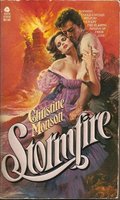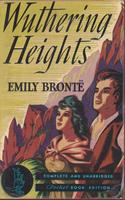Popular Romances as Primary Sources
I can read romance novels as research? Yes, really!
The romance genre of literature is as broad as any other fiction genre. When most people think of romance novels, they imagine paperbacks stocked in wire racks near the grocery store checkout—you know, the ones with cover illustrations of corset-wearing damsels swooning for a muscular man with a bare chest! But those types of romances didn’t become popular until the late 1970s; the history of the genre is much older than that. To liken all romance novels to bodice rippers and historicals, as many critics do, ignores the diversity, history, and influence of the genre. Contemporary romance scholars study far more than literature—they also use romances as primary source material for interdisciplinary studies involving social and cultural history, art, economics, sociology, and more!
Click each image on this page to learn a little more!
The Form of Romance Fiction
In the early 20th century, readers enjoyed romances as serial stories that appeared in weekly newspapers and magazines. The paperback revolution of the late 1930s changed America's reading habits by making book-buying affordable and enjoyable for the masses. No longer were books expensive collectors items or educational investments that could only be purchased at a bookstore or through a subscription service; anyone with a spare 25 cents could pick up a paperback, since they were conveniently stocked at street kiosks, newsstands, and drugstores.
At first, mass-market reprints of classic literature and "low-brow" genre fiction looked remarkably alike; publishing houses were happy to print any title, author, or genre that might sell well and all were marketed with a common pulp aesthetic. The pulp aesthetic that graced so much of print media was part of a larger artistic movement in the midcentury, which appeared in many media forms. Prominent artists worked as illustrators for popular magazines and books. As the book industry grew more competitive, publishers began specializing in particular genres and also developed genre-specific cover aesthetics. Romances, for example, were often identifiable by their pastel colors, floral embellishments, and cover illustrations that featured happy couples.
Just as sellers of other types of domestic goods devised new marketing strategies to target female consumers, so too did romance publishers tailor their marketing to female readers. Understood in the context of a period marked by rising American consumerism, can romance fiction be studied as a product? Given that romance novels dominated fiction sales (and still do), researchers interested in business history, market trends, or advertising might find them valuable to case studies.
The Content of Romance Fiction
Romance novels get a bad rap—and not just because of their cheesy covers. Literary critics cast aspersions when they call the genre “formula fiction.” By calling romance novels formulaic, people who are unfamiliar with the conventions of romance, and genre fiction more generally, are left assuming that romance authors use stock characters and recycled settings or plots because they lack the skill to craft truly original novels.
Romance novels have also been accused of harming women. Until the 1970s, romances were fairly wholesome and lacked sexual content; they focused on the sentimentality of courtship, which wrapped up in a happy engagement by the end of the story. In The Female Eunuch (1970), Germaine Greer chastised romance novels for promoting traditional views of marriage and monogamy—institutions she critiqued as patriarchal, capitalist and thus complicit in severing women from their own sexuality and power.
Two years later, Kathleen Woodiwiss published her novel The Flame and the Flower, which inclued graphic descriptions of physical intimacy. This novel was enormously popular and ushered in a new style of romance novels—the bodice ripper. Bodice rippers had female protagonists who acted upon their erotic desires, but the sex scenes were sometimes coercive and male characters were often aggressive. Feminist critics feared these new bodice rippers sanctioned domestic abuse and sexual violence and literary scholars accused romances of manipulating women into fantasizing about their own subjugation.
Since then, however, popular romance has evolved into a field of study in its own right and many scholars (feminists included) find that romance novels offer very complicated and nuanced representations of women and men. To continue to debate whether romances are antifeminist hamstrings scholars from analyzing other interesting elements and issues in their narratives as well as from considering other critical questions about their production and consumption. Throughout the rest of this exhibit, we'll take a look at a few of the reserach possibilities I identified from the narrative and paratextual content of nurse romance novels. Admittedly, my own research bias is toward historical analysis, but rest assured that nurse romance novels have content appropriate for any number of disciplines, which is precisely why we want to get more people interested in researching them!
Critical Thinking Prompts:
-
What kinds of information can artifacts from popular culture provide to a researcher? Is it different than the types of information you can learn from other sources?
-
Popular fiction stands outside of what is known as the "literary canon" and is often considered low-brow. What can you learn by reading literary fiction that isn't representative of elite or academic perspectives?
-
Aside from the textual narrative, what could you observe and analyze about a romance novel?
-
Primary sources from popular culture are often forms of consumer entertainment and were meant for a mass audience. How might that affect the messages and perspectives they communicated? Does that does that affect how a researcher interprets the artifact?
-
Romance fiction has been one of the most popular and profitable genres of literature since the 18th century but economic capital doesn't always translate automatically to academic legitimacy or cultural value? How does society define and/or consruct different forms of capital: economic, academic, cultural? Why do you think romance fiction doesn't yet have academic or cultural capital?
-
Romance novels have mostly been written and read by women. Publishers also primarily market them to women readers. But, there are still few women executives in the publishing industry. Do you think there is a relationship between the genre's reputation and its association with women?
-
As you move through the next few pages, think about the similiarties or difference between non-fcition texts and the nurse romance novels:
-
How do nurse biographies and memoirs function as a genre as opposed to romance fiction? Are the biographies and memoirs of real nurses distinguishable from fictional stories about nurses? If so, how?
-
Do the memoirs and biographies explain the nursing profession more accurately? Do the nurse biographies and memoirs provide a better understanding than nurse romance novels of the medical knowledge and technical skills needed to be a nurse?
-
Do non-fiction works romanticize the profession as much as the nurse romance novels? Do they have an agenda other than recording history or providing entertainment?
-


